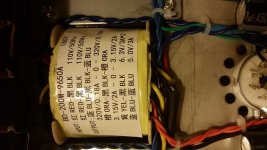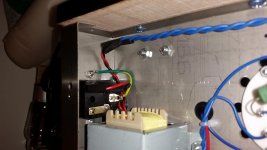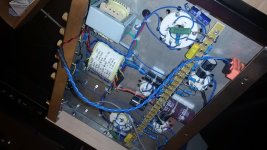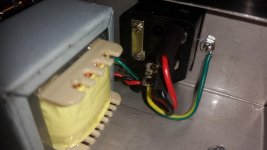Looking at the first photo it looks as if the red wires are connected together as the black wires are. Make sure the primaries are wired in series, ie; red live, black of that winding connect to the red of the other 110V winding , insulate the connection and connect the black from that winding to neutral.
The blue wires connect to one pair of the primaries. They are wired to the switch.
The other pairs of primaries are wires to the power input
Hopefully these extra photos help. I have pulled up the pair that goes to the switch for clarity
The other pairs of primaries are wires to the power input
Hopefully these extra photos help. I have pulled up the pair that goes to the switch for clarity
Attachments
As Walter has stated this two primary windings need to be in wired in seriesfor 220 volt operation.... i would check one lead at a time to see where it connects to... just my two pence worthcheck if the red wire of one winding and the and black wire of the other are connected together, in this case it is 220 vac; you must have one red and one black wire free to be connected to mains
Walter
The transformer seems to be wired for 220V (the two 110v primary windings in series: black wire from the first winding to other winding red wire), the picture is not very clear. But, I can tell for sure that the green/yellow earth protection wire is NOT wired according to IEC 60065 . I don't know the Australian regulation but I bet that the sloppy, dangerous solder job I see on the picture could not possibly be accepted. For your safety, please drill a new 3mm hole on the chassis near the power supply outlet, crimp a proper electrical terminal on the green/yellow wire, and secure it to the hole with a new 3mm screw with anti-slip washers.
Last edited:
I suspect the power switch is wired between the two primary windings which hopefully are in series. (Leaves one end of the winding connected to the mains at all time.)This actually isn't a very good idea and might violate safety standards. The remark about the grounding is also important and seems to be common problem in otherwise fairly well made amps, and needs to be fixed.
An old 220V transformer might not be happy with the typically higher 2016 line voltages.
There are electricity regs that specify voltage levels at the consumer point. Supply companies cannot violate them.
In countries that were deficit in power the voltages must have reached the specified regulations in the past decade but otherwise things have not changed. A transformer designed for 220V should be in fact happy to work at correct voltage than lower voltage.
Thanks all, as most of you have guessed, once I traced the wires I can see that it is wired in series with the switch connecting red and black from the different pair of windings. I switched it on and it all works fine.
Hi Kevin, could you please expain why this is not a good idea?
And what issues are there with the grounding shown in the photos I have posted?
This has been a valuable basic electronics lesson for me so I appreciate all the input. I learn best by asking questions rather than reading text books from cover to cover.
This actually isn't a very good idea and might violate safety standards. The remark about the grounding is also important and seems to be common problem in otherwise fairly well made amps, and needs to be fixed.
Hi Kevin, could you please expain why this is not a good idea?
And what issues are there with the grounding shown in the photos I have posted?
This has been a valuable basic electronics lesson for me so I appreciate all the input. I learn best by asking questions rather than reading text books from cover to cover.
Last edited:
An old 220V transformer might not be happy with the typically higher 2016 line voltages.
Even worse, we have 240v and it often exceeds 250V!
I will be buying a 240v to 220v drop down transformer in the next few days
Is it usually the transformer that can burn out if the voltage is too high. I'm guessing the tubes will also be stressed? They did feel very hot when I had it powered up last night.
I'll wait for the drop down transformer before I use the amp again
The standards in most Common Wealth countries is 230V and the tolerance is +6% to 10%. 250V is a bit high. Being a step-up transformer you need to be cautious.
I did suspect that they wired the switch in series with the two windings. Without tracing it it was not wise to say. I suggest you rewire the switch for safety else as Kevin pointed out above it's unsafe. The trafo will be always 'hot' irrespective of the switch position.
Desolder all wires, connect first primary red to switch and Live of main power to the other pole of switch. Connect black of this winding to red of the other winding, insulate. Connect black to neutral from the mains. If there is a second pole of switch wire the black of second winding and the neutral from mains. You get complete isolation.
I did suspect that they wired the switch in series with the two windings. Without tracing it it was not wise to say. I suggest you rewire the switch for safety else as Kevin pointed out above it's unsafe. The trafo will be always 'hot' irrespective of the switch position.
Desolder all wires, connect first primary red to switch and Live of main power to the other pole of switch. Connect black of this winding to red of the other winding, insulate. Connect black to neutral from the mains. If there is a second pole of switch wire the black of second winding and the neutral from mains. You get complete isolation.
110v x 2 = 220v?
given those conditions, what i do ois to connect those in series,
then attach a dmm set to read ac voltage...
i then inject a low voltage of say 6 volts, a small filament traffo is used here,
to the filament winding of the traffo in question....
then read the voltage on the series primaries, if it reads 220 or more,
then you made the correct connection, it the reading i closer to 0 volts,
then there is a mistake in series connection...
i have sent a tube amp to australia a couple of years ago,
i made the power traffo so that 220 or 240 volt primaries can be selected/
- Status
- This old topic is closed. If you want to reopen this topic, contact a moderator using the "Report Post" button.
- Home
- Design & Build
- Parts
- ID help - is this is a 110v or 220v transformer



